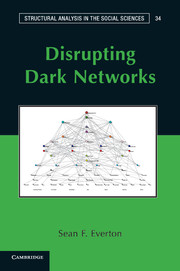Book contents
- Frontmatter
- Contents
- Figures
- Tables
- Preface
- Acknowledgments
- Part I Introduction
- Part II Social Network Analysis: Techniques
- Part III Social Network Analysis: Metrics
- Part IV Social Network Analysis: Advances
- Part V Conclusion
- Appendix 1 The Noordin Top Terrorist Network
- Appendix 2 Glossary of Terms
- Appendix 3 Multidimensional Scaling with UCINET
- Appendix 4 The Just War Tradition
- References
- Index
Preface
Published online by Cambridge University Press: 05 April 2013
- Frontmatter
- Contents
- Figures
- Tables
- Preface
- Acknowledgments
- Part I Introduction
- Part II Social Network Analysis: Techniques
- Part III Social Network Analysis: Metrics
- Part IV Social Network Analysis: Advances
- Part V Conclusion
- Appendix 1 The Noordin Top Terrorist Network
- Appendix 2 Glossary of Terms
- Appendix 3 Multidimensional Scaling with UCINET
- Appendix 4 The Just War Tradition
- References
- Index
Summary
The Problematic Nature of Dark Networks
This book is concerned with the use of social network analysis (SNA) for tracking, destabilizing, and disrupting dark networks. Following Jörg Raab and Brint Milward, dark networks are defined here as covert and illegal networks (Milward and Raab 2006; Raab and Milward 2003), namely, any group that seeks to conceal itself and its activities from authorities. While the term is typically used to refer to groups such as terrorists, gangs, drug cartels, arms traffickers, and so on, it can refer to benign groups as well. For instance, Żegota, the predominantly Roman Catholic underground organization that addressed the social welfare needs of Jews in German-occupied Poland from 1942 to 1945 (Tomaszewski and Webowski 1999), would be considered a dark network because it was covert and, at least from the perspective of the Nazis, illegal. That said, this book implicitly assumes that the theories and methods it discusses will be used for the disruption of dark networks that seek to harm innocent civilians and the societies in which they live.
Social network analysts have long considered the nature of dark networks. Georg Simmel (1906, 1950b), for example, was one of the first to explore their structure in his essay on secret societies, a study that Bonnie Erickson (1981) later expanded and modified. A decade later Malcolm Sparrow (1991) considered the usefulness of SNA for tracking criminal networks, and Wayne Baker and Richard Faulkner (1993) used SNA to examine three price-fixing conspiracy networks in the heavy electrical equipment industry. Since 9/11, analysts have become increasingly drawn to the use of SNA as a tool for understanding dark networks (Reed 2007; Ressler 2006), largely because of Valdis Krebs's (2001) analysis of the 9/11 hijacker network. For instance, Sageman (2004) analyzed the network of 172 Islamic terrorist operatives affiliated with the global salafi jihad; José Rodriguez (2005) mapped the March 11, 2004, Madrid bombings; and Ami Pedahzur and Arie Perliger (2006) examined the nature of suicide attack networks. These, of course, are just a few examples; several other notable studies exist (see, e.g., Asal and Rethemeyer 2006; Carley 2003a; Koschade 2006; Magouirk, Atran, and Sageman 2008; Moody 2005; Tsvetovat and Carley 2005; van Meter 2001), many of which we will consider later in the book.
- Type
- Chapter
- Information
- Disrupting Dark Networks , pp. xxv - xxxivPublisher: Cambridge University PressPrint publication year: 2012



